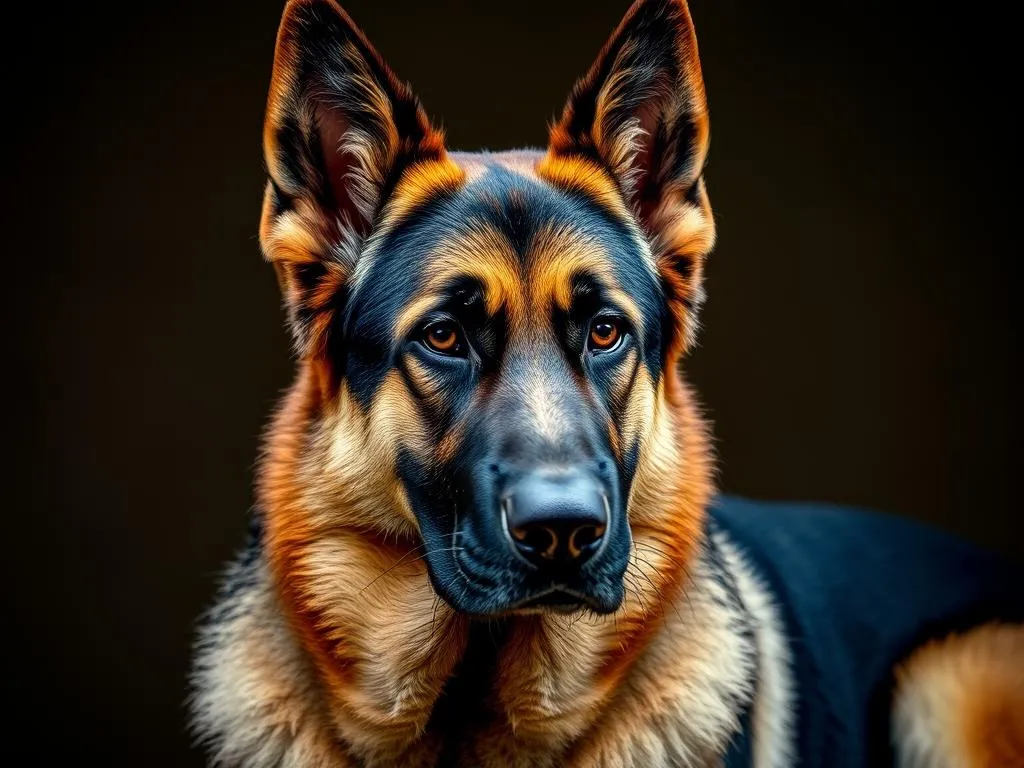
Introduction
The German Shepherd and Bloodhound are two of the most beloved dog breeds, each with its own unique characteristics and history. The German Shepherd, known for its intelligence and loyalty, has a rich background as a working dog, originally bred for herding. The Bloodhound, famed for its incredible sense of smell, has been a trusted companion in search and rescue for centuries. Mixing these two breeds results in a hybrid known as the German Shepherd Bloodhound mix, a dog that combines the best traits of both parent breeds.
Mixed breeds have gained immense popularity due to their diverse traits and often unique appearances. The purpose of this article is to provide comprehensive information about the German Shepherd Bloodhound mix, including its characteristics, training needs, health considerations, and more. Understanding this hybrid breed is crucial for potential owners to ensure they meet their needs and provide a loving home.
Understanding the Parent Breeds
German Shepherd
The German Shepherd has its origins in Germany, where it was developed in the late 19th century primarily for herding sheep. This breed quickly gained recognition for its intelligence, versatility, and protective instincts.
Physical Characteristics: German Shepherds are large, robust dogs with a strong build. They typically weigh between 50 to 90 pounds and stand about 22 to 26 inches tall. Their double coat can vary in color, with black and tan being the most common.
Temperament and Personality Traits: Known for their loyalty and courage, German Shepherds are intelligent and eager to learn. They are excellent working dogs, often used in police and military roles. However, they require socialization and training from an early age to ensure they develop into well-rounded adults.
Common Health Issues: While generally healthy, German Shepherds are prone to certain health issues, including hip dysplasia, elbow dysplasia, and degenerative myelopathy. Regular veterinary check-ups and a healthy diet are essential for maintaining their well-being.
Bloodhound
The Bloodhound, known for its remarkable sense of smell, has a history that dates back to medieval times. Originally bred in Belgium for tracking game, these dogs are now often used in search and rescue missions due to their unparalleled olfactory abilities.
Physical Characteristics: Bloodhounds are large, droopy-faced dogs that typically weigh between 80 to 110 pounds and stand about 23 to 27 inches tall. They have loose, wrinkled skin and long ears, which enhance their sense of smell. Their coat is short and can come in various colors, including black and tan, liver and tan, or red.
Temperament and Personality Traits: Bloodhounds are gentle, affectionate, and known for their friendly demeanor. They are great with children and other pets but can be stubborn. Early training and socialization are crucial to curbing any unwanted behaviors.
Common Health Issues: Bloodhounds may face health challenges such as hip dysplasia, ear infections, and obesity. Their loose skin requires regular cleaning to prevent infections, and they should have regular vet visits to monitor their health.
Characteristics of the German Shepherd Bloodhound Mix
Physical Traits
The German Shepherd Bloodhound mix can vary significantly in size and appearance, depending on which traits are more pronounced from each parent breed. Generally, this mix will weigh between 60 to 100 pounds and stand about 22 to 28 inches tall.
Coat Type and Color Variations: This hybrid may inherit the double coat of the German Shepherd or the short, loose coat of the Bloodhound. Colors can range from black and tan to solid colors, often reflecting a mix of both breeds.
Distinctive Features: Expect to see a combination of the German Shepherd’s erect ears and the Bloodhound’s droopy ears. The mix may also have a strong, muscular build indicative of both parents.
Temperament
The German Shepherd Bloodhound mix tends to inherit a blend of traits from both parent breeds. This mix is typically loyal, intelligent, and eager to please, making them highly trainable.
Behavioral Traits: These dogs can be protective like the German Shepherd while also being friendly and sociable like the Bloodhound. They may display a natural curiosity, especially when it comes to scents, making them excellent companions for outdoor activities.
Intelligence and Trainability: This hybrid is often very intelligent, benefiting from the German Shepherd’s trainability. However, the stubbornness of the Bloodhound can come into play, so consistent training methods are essential.
Socialization Needs: Early socialization is critical for the German Shepherd Bloodhound mix to develop good manners and confidence. They generally get along well with children and can cohabitate with other pets if properly socialized.
Health Considerations
As with any hybrid breed, the German Shepherd Bloodhound mix may inherit health issues from either parent.
Potential Hereditary Health Issues: Some common health concerns include hip and elbow dysplasia, ear infections (common in Bloodhounds), and obesity. Regular veterinary visits and a balanced diet can help mitigate these risks.
Lifespan Expectations: This mix typically has a lifespan of 10 to 14 years, which is relatively standard for large breeds.
Importance of Regular Veterinary Check-Ups: Routine check-ups are essential to monitor health, vaccinations, and any developing issues.
Training and Socialization
Basic Training Techniques
Training is a vital aspect of owning a German Shepherd Bloodhound mix.
Importance of Early Training: Starting training early helps shape good behavior and establishes a strong bond between the dog and owner.
Recommended Training Methods: Positive reinforcement techniques work best for this mix. Using treats, praise, and playtime can motivate them to learn commands and behaviors.
Socialization Strategies
Socializing your German Shepherd Bloodhound mix is crucial to develop a well-adjusted dog.
How to Introduce to Different Environments: Gradually expose your dog to various environments, sounds, and people. This approach helps them adapt and respond positively to new experiences.
Importance of Socializing with Other Dogs and People: Regular playdates with other dogs and encounters with new people can enhance your dog’s social skills and reduce fear or aggression towards strangers.
Exercise and Activity Requirements
The German Shepherd Bloodhound mix is an active breed that requires a good amount of exercise to stay healthy and happy.
Recommended Daily Exercise Routines: Aim for at least 60 to 90 minutes of exercise per day, which can include walks, runs, or play sessions in a secure area.
Playtime and Mental Stimulation Activities: Engaging activities like fetch, agility training, and scent work can provide both physical and mental stimulation.
Impact of Exercise on Behavior and Health: Regular exercise can prevent behavioral issues arising from boredom and helps maintain a healthy weight, which is essential for the longevity of your dog.
Grooming Needs
Grooming is an essential aspect of care for the German Shepherd Bloodhound mix.
Coat Maintenance Based on Physical Traits: Depending on the coat type, grooming needs may vary. A double coat requires more frequent brushing (2-3 times a week), while a shorter coat may need less.
Bathing Frequency and Products to Use: Bath your dog as needed, typically every 6 to 8 weeks, using a gentle dog shampoo to avoid irritation.
Nail Trimming and Dental Care: Regular nail trimming is essential to prevent overgrowth and discomfort. Dental care should also be a part of your grooming routine, with regular brushing and dental treats to maintain oral health.
Nutrition and Diet
Proper nutrition is crucial for the well-being of your German Shepherd Bloodhound mix.
Recommended Dietary Needs for the Mix: A balanced diet that includes high-quality protein, healthy fats, and essential vitamins is important.
Tips for Choosing Quality Dog Food: Select dog food that meets the specific needs of large breeds, ensuring it is free from fillers and artificial additives. Consult with your veterinarian for specific recommendations based on your dog’s age, weight, and activity level.
Importance of Portion Control and Feeding Schedule: Establishing a regular feeding schedule and controlling portion sizes can help prevent obesity, which is a common concern in larger breeds.
Living Environment
The living environment plays a significant role in the happiness of a German Shepherd Bloodhound mix.
Best Living Situations: While they can adapt to apartment living, a house with a yard is ideal for this energetic mix.
Space Requirements: Ensure there is enough space for your dog to move around comfortably and engage in play.
Tips for Creating a Dog-Friendly Home Environment: Designate a comfortable area for your dog to relax, provide toys for mental stimulation, and ensure safety by securing hazardous items.
Cost of Ownership
Owning a German Shepherd Bloodhound mix comes with various expenses.
Initial Costs: Adoption or purchase fees can vary widely, along with initial vaccinations, spaying/neutering, and supplies like crates and bedding.
Ongoing Expenses: Monthly costs will include food, grooming, and routine vet care, which can add up over time.
Additional Considerations: Training classes, pet insurance, and unexpected medical expenses should also be considered in your budget.
Conclusion
Owning a German Shepherd Bloodhound mix can be incredibly rewarding. This hybrid breed combines the intelligence, loyalty, and protective nature of the German Shepherd with the gentleness and keen tracking abilities of the Bloodhound. However, potential owners should be aware of the unique challenges involved, including training, exercise requirements, and health considerations.
Thorough research is essential before adopting a mixed breed dog to ensure you can meet their needs and enjoy the companionship they offer. Ultimately, a German Shepherd Bloodhound mix can bring joy and fulfillment to any dog lover’s life.
FAQs
What is the temperament of a German Shepherd Bloodhound mix?
This mix is generally loyal, intelligent, and friendly, making them great family pets when properly socialized.
Are German Shepherd Bloodhound mixes good with children?
Yes, they can be excellent with children, especially when raised together and socialized from a young age.
How much exercise does a German Shepherd Bloodhound mix need?
They typically require at least 60 to 90 minutes of exercise daily to keep them healthy and happy.
What are common health issues for this mix?
Potential health concerns include hip dysplasia, obesity, and ear infections, so regular vet check-ups are essential.
How can I train a German Shepherd Bloodhound mix?
Using positive reinforcement techniques and starting with early training can help shape good behavior and obedience.
By understanding the characteristics, needs, and potential challenges of the German Shepherd Bloodhound mix, you can ensure a happy and fulfilling life for both you and your canine companion.









